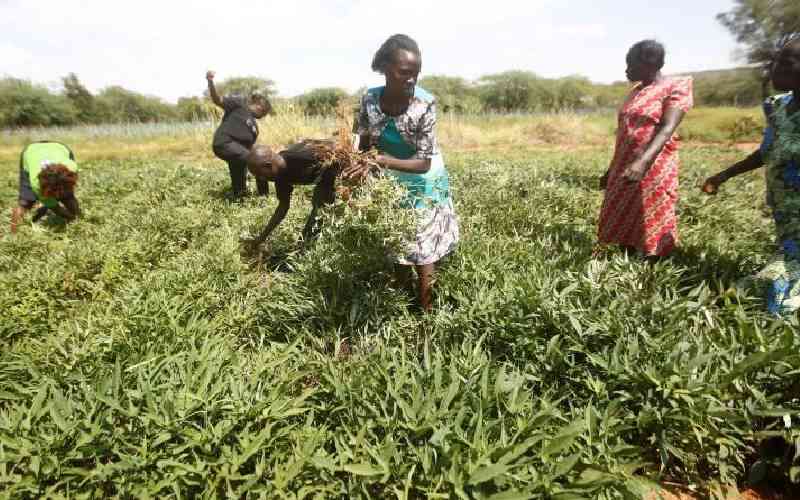Agriculture has always been dependent on the weather. Farmers need a steady mixture of sun, warmth, and rains to produce food.
On the other hand, agriculture has become a carbon-intensive endeavour. Crop, livestock and fossil fuel use in agriculture account for about 25 per cent of global greenhouse gas (GHG) emissions.
While food security holds key to the prosperity of any country, providing growing populations with sufficient and nutritious food remains a challenge. Reliance on seasonal subsistence farming and the slow adoption of modern farming means that chronic malnutrition and acute food shortages will remain a reality.
A revitalisation of rural areas is urgently needed to stop rising malnutrition rates, according to the Global Food Policy Report, published by the International Food Policy Research Institute (IFPRI).
Such revitalisation could address the multiple crises facing rural areas, including malnutrition rates which, in 2018, jumped for the third year in a row; with 821 million people globally now facing chronic food deprivation.
The number of extreme climate-related disasters, including extreme heat, drought, floods and storms, have doubled since the early 1990s, with an average of 213 of these events occurring every year during the period of 1990–2016. The agricultural sector is especially prone to these increasing risks.
Extreme weather
While losses due to climate variability and extreme weather events harm the agricultural productivity and contribute to shortfalls in food availability, knock-on effects causing food price hikes and income losses that reduce people’s access to and worsen the possibility of the utilization of food. In addition, nutrition is highly susceptible to changes in climate.
Climate variability is in addition negatively undermining production of major crops in tropical regions and, without adaptation and risk reduction measures, this is expected to worsen as temperatures increase and become more extreme.
The nature of rainy seasons is changing, especially the timing of seasonal climate events.
Farmers in Sub-Saharan Africa are particularly vulnerable. Every year has its own challenges, but thanks to climate change, farmers are now facing greater difficulties, like, extreme weather manifest in droughts, floods, severe storms, heat waves; Pests and diseases where changes in temperatures and moisture conditions can allow crop diseases and pests to migrate into new areas.
Recently, Sub-Saharan Africa has witnessed the spread of fall army worms, an invasive caterpillar that can devastate maize yields when left unchecked. If global temperatures increase by 4 degrees Celsius by the year 2100, maize yields in some African countries would probably decline by more than 20 percent, according to a study published last year.
Climate change
Kenya has the largest, most diversified economy in East Africa with agriculture as the backbone of the economy and central to the country’s development strategy. More than 75 percent of Kenyans make some part of their living in agriculture, and the sector accounts for more than a fourth of Kenya’s gross domestic product (GDP). The Kenyan government however, expects the economy to grow by 6.3 percent in 2019.
However, agricultural productivity has gradually stagnated in recent years, despite continuous population growth. Moreover, only about 20 percent of Kenyan land is suitable for farming, and in these areas maximum yields have not been achieved, leaving considerable potential for increases in productivity and despite agriculture’s key role in addressing the food security problem, the sector faces myriad challenges especially climate change, water scarcity, diminishing arable land, soil degradation and rural-urban migration.
Stay informed. Subscribe to our newsletter
To deal with the issue of food security, we need to look beyond policy actions to innovation. Such as addressing changing climate variability and extremes and their impact on agricultural livelihoods, food security and nutrition.
The implementation of climate resilience policies, programmes and practices means adopting and refitting tools and interventions such as: risk monitoring and early warning systems; emergency preparedness and response; vulnerability reduction measures; shock-responsive social protection, risk transfers and forecast-based financing; and strong risk governance structures in the environment, food, health system nexus.
Agriculture is a unique sector for a just transition. It is both source of greenhouse gasses as well as a “sink” where crops and soils can capture carbon. We should exploit this feature as leverage in developing local and global strategies for a just agricultural transition. And for the growth of EAC and Africa, I feel there should be an increase in farming partnerships.
Mr Diaz is a Business Leader & Director EABC. [email protected]
 The Standard Group Plc is a
multi-media organization with investments in media platforms spanning newspaper
print operations, television, radio broadcasting, digital and online services. The
Standard Group is recognized as a leading multi-media house in Kenya with a key
influence in matters of national and international interest.
The Standard Group Plc is a
multi-media organization with investments in media platforms spanning newspaper
print operations, television, radio broadcasting, digital and online services. The
Standard Group is recognized as a leading multi-media house in Kenya with a key
influence in matters of national and international interest.
 The Standard Group Plc is a
multi-media organization with investments in media platforms spanning newspaper
print operations, television, radio broadcasting, digital and online services. The
Standard Group is recognized as a leading multi-media house in Kenya with a key
influence in matters of national and international interest.
The Standard Group Plc is a
multi-media organization with investments in media platforms spanning newspaper
print operations, television, radio broadcasting, digital and online services. The
Standard Group is recognized as a leading multi-media house in Kenya with a key
influence in matters of national and international interest.








